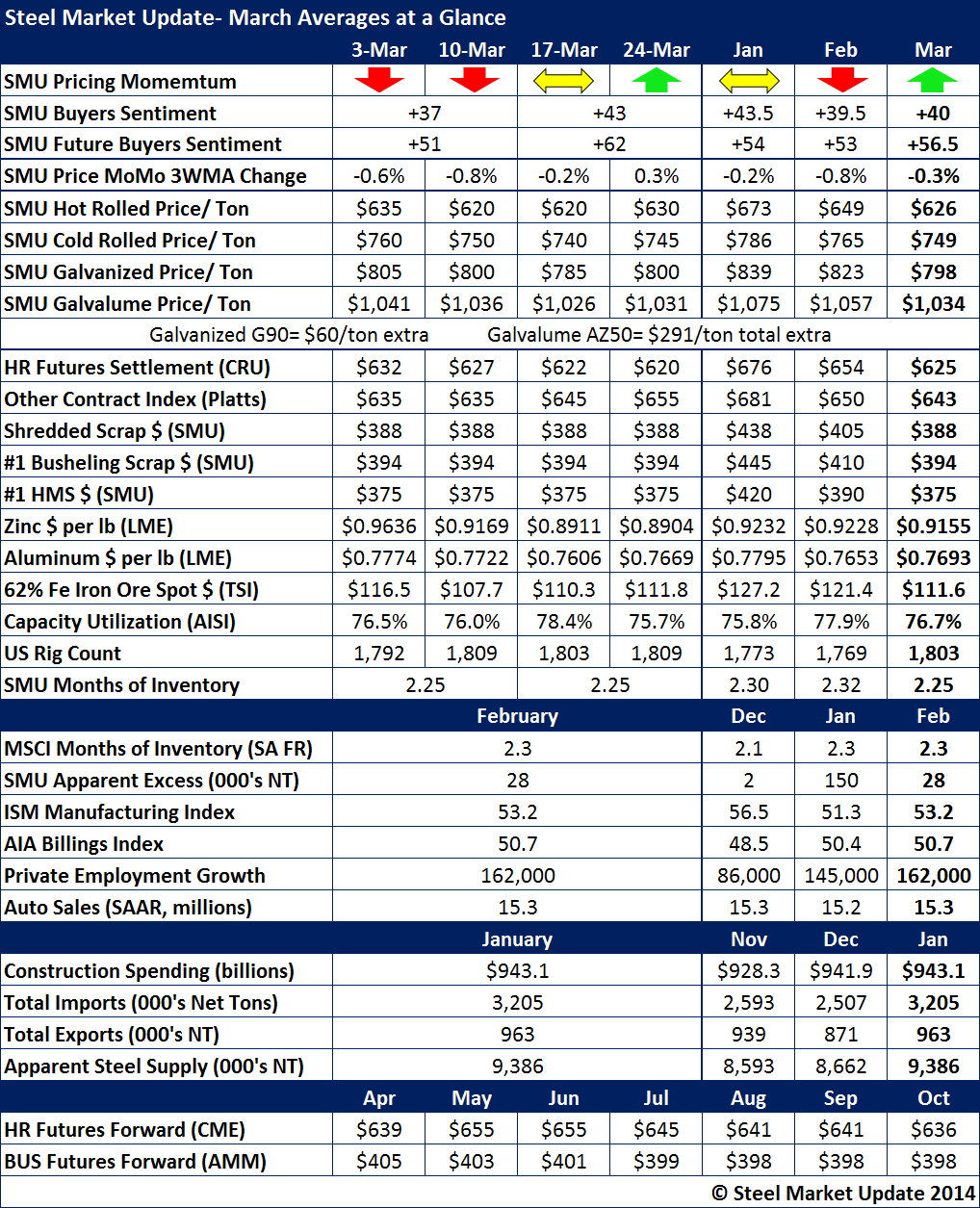SMU Data and Models

March at a Glance
Written by John Packard
April 1, 2014
Flat rolled steel pricing momentum reversed course due to the price increase announcement led by ArcelorMittal and followed by virtually all of the domestic and Canadian steel mills. We moved the SMU Price Momentum Indicator first to Neutral and then a week later to Higher in response to the increase announcements and the fact that the mills began collecting higher prices on flat rolled steels.
The SMU Steel Buyers Sentiment Index last measured in mid-March was +40 which is well within the optimistic range of our Index.
Hot rolled prices averaged $626 per ton for the month which was $1 per ton higher than the CRU average of $625 per ton. We are adding a new line item to our monthly recap. The line item is noted as Other Contract Index Platts so our readers can compare CRU, Platts and SMU with CRU and Platts now being used as contract adjustment vehicles. Platts average for HRC for the month was $643 per ton, $18 per ton higher than CRU and $17 per ton higher than SMU.
Scrap prices were down in the Chicago area markets. Iron ore spot pricing in China was also down although the commodity has been bouncing back over the past few days.
SMU service center inventories stood at 2.25 months as of mid-March while MSCI had their inventories at 2.3 months on a seasonally adjusted basis as of the end of February.
Auto sales have been lower than originally forecast at 15.3 million units (annualized) at the end of February. Projections are for sales closer to 16.5 million units during the full calendar year.


John Packard
Read more from John PackardLatest in SMU Data and Models

SMU Scrap Survey: Sentiment Indices rise
Both current and future scrap sentiment jumped this month, though survey participants reported responses before key trade news was announced.

SMU Survey: Sentiment splits, buyers have better view of future than the present
SMU’s Steel Buyers’ Sentiment Indices moved in opposite directions this week. After rebounding from a near five-year low in late June, Current Sentiment slipped again. At the same time, Future Sentiment climbed to a four-month high. Both indices continue to show optimism among buyers about their company’s chances for success, but suggest there is less confidence in that optimism than earlier in the year.

SMU scrap market survey results now available
SMU’s ferrous scrap market survey results are now available on our website to all premium members. After logging in at steelmarketupdate.com, visit the pricing and analysis tab and look under the “survey results” section for “ferrous scrap survey” results. Past scrap survey results are also available under that selection. If you need help accessing the survey results […]

SMU flat-rolled market survey results now available
SMU’s latest steel buyers market survey results are now available on our website to all premium members. After logging in at steelmarketupdate.com, visit the pricing and analysis tab and look under the “survey results” section for “latest survey results.” Past survey results are also available under that selection. If you need help accessing the survey results, or if […]

SMU Survey: Sheet lead times stabilize, plate contracts
Mill lead times for sheet products were steady to slightly longer this week compared to our late June market check, while plate lead times contracted, according to steel buyers responding to this week’s market survey.
